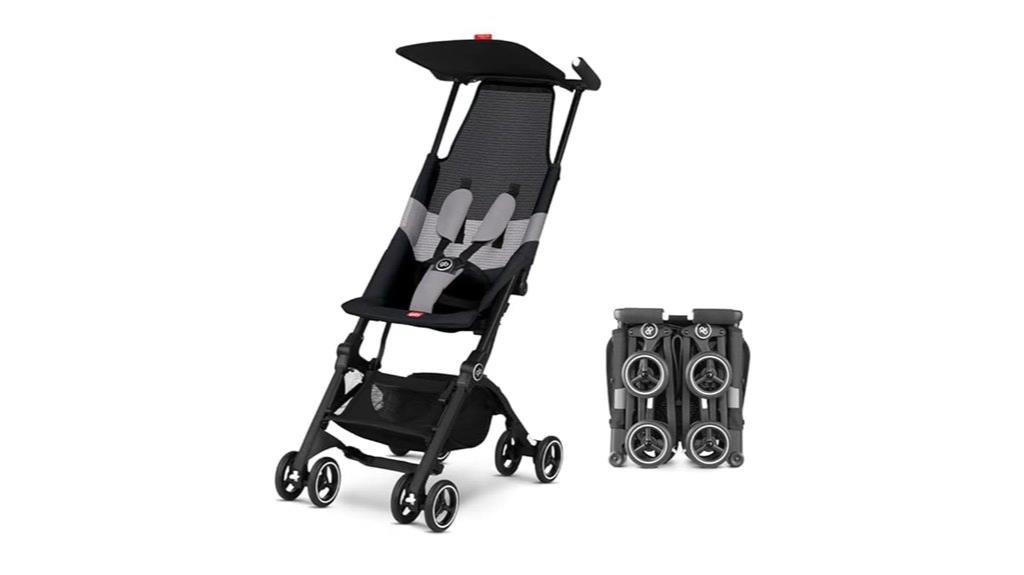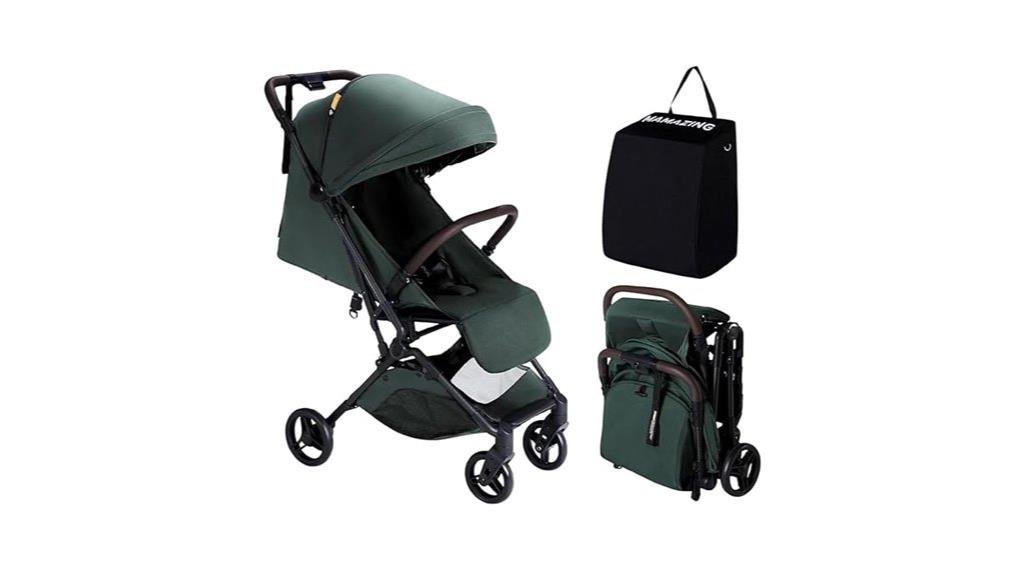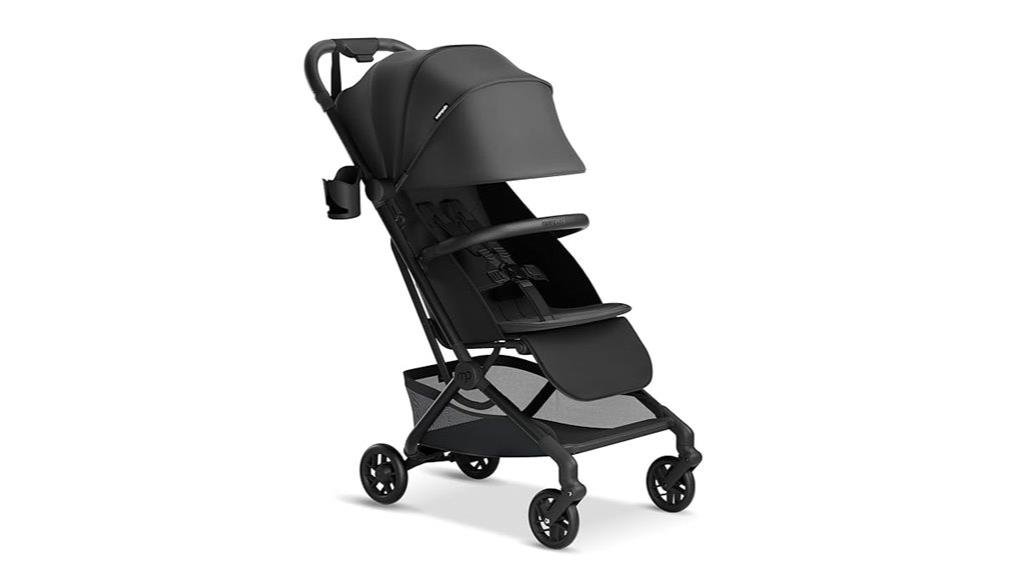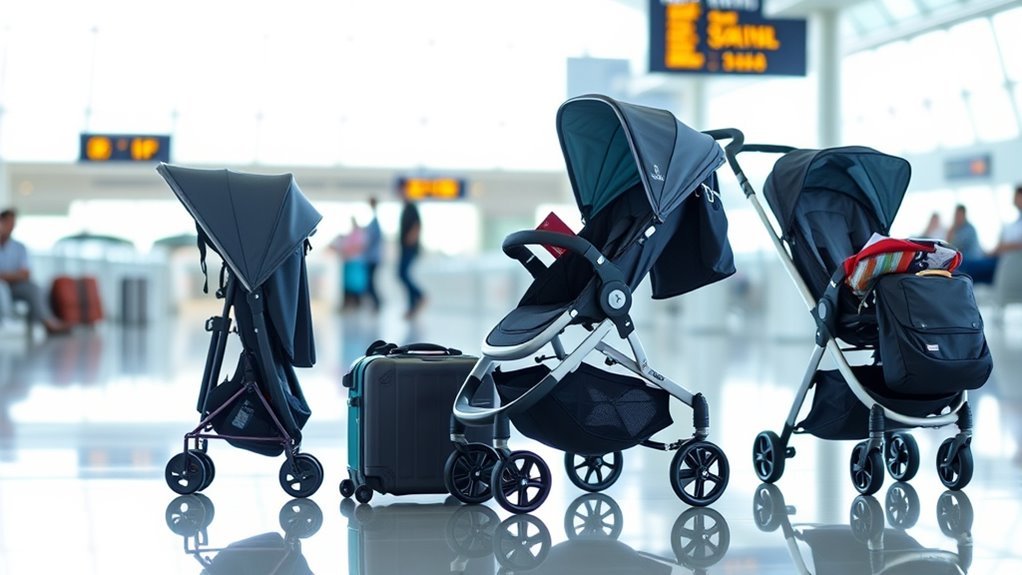Like a small sail catching the breeze, we’re always looking for gear that makes travel feel effortless. We’ll walk you through three airport strollers that balance featherweight portability with real-world comfort and safety. Each one folds down for tight spaces and quick moves through terminals, but the differences matter—so stay with us to find which best fits your family’s travel style.
gb Pockit Air All Terrain Travel Stroller (Velvet Black)

If you need an ultra-compact stroller that fits as carry-on luggage, the gb Pockit Air All Terrain is your best choice—it’s light enough at 4.6 lb frame weight and folds down to a handbag-sized 11.8 x 7 x 13.8 inches, so you can stash it in overhead bins or tuck it under a car seat during tight transfers. You’ll appreciate the breathable mesh backrest for hot days and the optional snug padded inlay when it’s cooler. Double wheels help on varied surfaces, and the aluminum frame keeps weight low. It holds up to 55 lb, has a 3-point harness, and comes with a two-year warranty.
Best For: travelers and parents needing an ultra-compact, lightweight stroller that fits as carry-on luggage and is easy to lift and store during trips.
Pros:
- Extremely compact fold (11.8 x 7 x 13.8 in) and airplane hand-luggage compliant for easy travel and overhead-bin storage.
- Very lightweight aluminum frame (4.6 lb frame weight, 10.4 lb total) makes it easy to carry and maneuver.
- Breathable mesh backrest, optional padded inlay, and double wheels improve comfort and usability across varied temperatures and surfaces.
Cons:
- Not compatible with car seats, limiting use for newborn travel systems.
- No built-in brake system and only a 3-point harness (not 5-point), which may concern some safety-focused parents.
- Plastic/EVA tires and minimal suspension can feel less smooth on rough terrain compared with full-size strollers.
MAMAZING Lightweight Baby Travel Stroller with Carbon Fiber Frame

For parents who prioritize ultra-lightweight portability without sacrificing durability, the MAMAZING Lightweight Baby Travel Stroller with its carbon fiber frame is a standout choice — you’ll notice how easy it is to lift, fold, and stow in an airplane overhead bin or car trunk. Weighing 11.6 lbs and folding to 20.6 x 18.5 x 11 inches, it’s airline-friendly and fits tight spaces. You’ll get a one-handed fold, UPF 50+ canopy, roomy under-seat basket, faux-leather padded seat, and a 5-point harness with foot brake. It supports toddlers from 6 months to 50 lbs and meets CPSC/ASTM safety standards.
Best For: Parents and caregivers who need an ultra-light, airline-friendly stroller for travel and everyday outings with toddlers up to 50 lbs.
Pros:
- Extremely lightweight (11.6 lbs) with a carbon fiber frame for easy lifting and travel.
- One-handed fold and compact folded size (20.6 x 18.5 x 11 in) that fits airplane overhead bins and small trunks.
- UPF 50+ canopy, spacious under-seat basket, padded faux-leather seat, and 5-point harness for comfort and safety.
Cons:
- Limited basket weight capacity (4.4 lbs) may restrict how much you can carry underneath.
- Smaller 5.5-inch front wheels may be less smooth on rough terrain compared with larger-wheel strollers.
- Warranty limited to Amazon’s voluntary 30-day return guarantee; may lack longer manufacturer coverage.
Mompush Velo Lightweight Travel Stroller (Compact, Airplane-Friendly)

Traveling parents who need an airplane-friendly, ultra-compact stroller will appreciate the Mompush Velo’s one-second fold and carry-on–compatible size, which slips into overhead bins or tight trunks without fuss. You’ll find it weighs under 17 lbs and folds to roughly 19.6 x 18.1 x 8 inches, meeting IATA hand-luggage guidelines. It reclines near-flat for newborns, supports toddlers up to 50 lbs, and has a padded seat, adjustable footrest and UPF canopy. Safety features include a 5-point magnetic harness and ASTM/CPSC compliance. Full suspension, PU puncture-resistant tires and one-handed steering make airport maneuvers effortless.
Best For: Traveling parents who need an airplane-friendly, ultra-compact stroller that’s lightweight yet suitable from newborn to toddler.
Pros:
- One-second fold into IATA carry-on–compatible size and under 17 lbs for easy overhead bin storage and travel.
- Near-flat recline, padded seat, adjustable footrest, and UPF canopy for newborn comfort and toddler support up to 50 lbs.
- Safety-certified (ASTM/CPSC) with 5-point magnetic harness, full suspension, puncture-resistant PU tires, and one-handed steering for smooth maneuverability.
Cons:
- Some accessories (infant car seat adapters, snack tray) sold separately, adding to overall cost.
- Compact size and lightweight build may offer less ruggedness than full-size all-terrain strollers.
- Warranty limited to Amazon’s voluntary 30-day return guarantee rather than a longer manufacturer warranty.
Factors to Consider When Choosing an Airport Stroller
Let’s look at the key factors that make an airport stroller truly travel-ready: how small it folds, whether it fits as carry-on, its weight and portability, wheel quality for smooth maneuvering, and the type of safety harness. We’ll compare compact folded dimensions and airline carry-on rules so you know what’ll pass at the gate. Then we’ll assess weight, ease of carrying, wheel performance, and harness security to help you pick the best match for your trips.
Size When Folded
A stroller’s folded dimensions often determine whether we breeze through the airport or wrestle with gate check lines, so we should prioritize models that meet common carry-on limits (around 22 x 14 x 9 inches) while still packing the features we need. Compact folded size matters: the gb Pockit Air, at 11.8 x 7 x 13.8 inches, tucks into tight spaces, while the MAMAZING’s 20.6 x 18.5 x 11 inches balance compactness and stability. Smaller packages make carrying, stowing, and moving between terminals far easier, especially when we’re juggling bags or children. Ultra-compact designs that fold into handbag-sized carriers cut hassle further and speed up shifts. When comparing strollers, we should measure folded dimensions, check real-world storage behavior, and prioritize portability without sacrificing safety or comfort.
Carry-On Compatibility
Folded size tells us whether a stroller will fit in overhead bins or force a gate check, but carry-on compatibility goes beyond raw dimensions — we need to confirm airline rules, folding style, and weight before booking. We always check airline carry-on size limits (often ~22 x 14 x 9 inches) so we don’t face fees or last-minute gate hassles. We favor ultra-compact folding mechanisms that become handbag-shaped packages for easy stowing overhead or under a seat. One-handed, quick folds are essential when we’re juggling children and bags. While weight matters, here we focus on whether the folded dimensions and shape meet specific carrier policies—some airlines enforce unique measurements—so we recommend verifying your airline’s rules before you fly.
Weight and Portability
When we pick an airport stroller, weight and portability should drive our choices because light, compact models make navigation, gate checks, and overhead-stow decisions far easier. We prioritize strollers in the 10–12 pound range so carrying between terminals and lifting into bins doesn’t exhaust us. Folded size matters as much as weight; we aim for roughly 20-inch height and width to fit standard overhead compartments and avoid gate-checking. One-handed folding is a must — it frees one hand for luggage or our child while collapsing the stroller quickly. We also check for a 50-pound weight capacity so the stroller stays useful as our child grows. Balancing featherlight construction with durable materials gives us reliable, travel-ready gear.
Maneuverability and Wheels
Because airports throw a mix of smooth concourses and unpredictable surfaces at us, we focus on strollers that steer easily and roll smoothly so we can move quickly without tipping our balance. Double wheels boost stability and help us weave through crowds, while one-handed steering lets us manage luggage and kids at the same time. Lightweight models under about 11 pounds reduce arm strain and make lifting into overhead bins or trunks easier. Compact folded widths—ideally under 12 inches—mean less hassle storing strollers on planes or in tight airport spaces. For comfort and control, full suspension plus puncture-resistant tires smooth bumps and prevent delays from flats, so we keep our pace and avoid unnecessary stops during travel.
Safety Harness Type
Good maneuverability gets us through the airport, but we still need a harness that keeps our child secure while we move. We prefer strollers with a 5-point harness because it restrains shoulders, waist, and between the legs, cutting escape and injury risk compared with 3-point systems. Always check that the harness meets CPSC and ASTM standards so we’re relying on verified safety. Equally important is ease of adjustment: quick, intuitive straps let us tighten or loosen the fit during boarding or gate waits without fumbling. Aim for a snug fit that isn’t restrictive — snugness keeps the child secure during turns and sudden stops while preserving comfort. Prioritize reliable buckles and adjustable straps when choosing an airport stroller.
Recline and Comfort
Although we want a lightweight, easy-to-fold frame, recline and comfort are what keep kids settled on long airport days, so we make them a priority. We look for near-flat recline to accommodate newborns safely and let them nap without strain. For toddlers, adjustable footrests let them find a comfortable position and prevent legs from dangling. Padded seats add softness for long waits and walks, reducing fussiness and pressure points. Canopies with UPF protection are non-negotiable — they shield young skin from sun while the child rests. The ideal stroller balances supportive structure with gentle cushioning so it adapts from infancy through toddlerhood. Prioritizing these features keeps travel smoother for both child and caregiver.
Storage and Accessories
Many of our airport days hinge on smart storage and useful accessories, so we prioritize strollers with roomy under-seat baskets, easy one-handed folds, and modular add-ons that make movement simpler. We check basket size—models like the MAMAZING stroller carry essentials, snacks, and a small tote without slowing us down. Compact folding is nonnegotiable; strollers that collapse small enough for overhead bins or trunks, such as the Mompush Velo, reduce hassle between gates. We also value practical accessories: cup holders, rain covers, and attachable storage bags keep items organized and protected. An adjustable canopy, like on the MAMAZING lightweight version, adds UV protection during outdoor waits. Above all, user-friendly folding mechanisms and modular options make airport shifts smoother and less stressful.
Frequently Asked Questions
Can These Strollers Fit in Overhead Airplane Compartments?
Usually yes — we’ve found many compact airport strollers fit overhead bins, but sizes vary by airline and model. We recommend measuring folded dimensions, checking your carrier’s policy, and testing the fold before your trip.
Are Replacement Wheels or Parts Widely Available?
Like a toolbox opening, yes — we’ve found replacement wheels and parts are generally available from manufacturers and third-party sellers; we’ll check model-specific compatibility, order authentic or aftermarket components, and keep spares for travel peace-of-mind.
Do Any Models Accommodate Car Seats Directly?
Yes — many do. We’ll choose travel strollers with integrated car-seat compatibility or simple adapter systems, so you can click infant carriers on and off, keeping travel smooth and avoiding unnecessary transfers for baby.
How Do These Strollers Perform on Uneven Outdoor Terrain?
They handle light uneven terrain okay; we’d avoid rough trails. Their small wheels limit suspension and clearance, so bumps transmit more. We recommend choosing models with good suspension and larger wheels if you’ll frequently face rough surfaces.
Are There Weight or Age Limits for Infant Use?
Yes — most strollers cap weight and age: we’ll usually see limits like 40–55 pounds or “up to about 4–5 years,” and infants often need a newborn-safe recline or car-seat adapter before rear-facing use.
Conclusion
We’ve seen three strollers that practically collide on the runway of parents’ needs: the gb Pockit Air with its ultra-compact mesh backrest, the featherlight MAMAZING with carbon fiber ease, and the Mompush Velo that folds in a second and keeps safety first. Together they prove you don’t have to sacrifice comfort or security for portability — so whether you’re sprinting to a gate or strolling between terminals, one of these will fit right into your travel plans.
